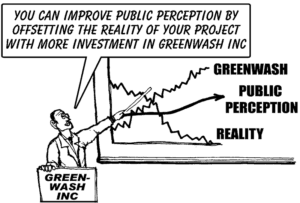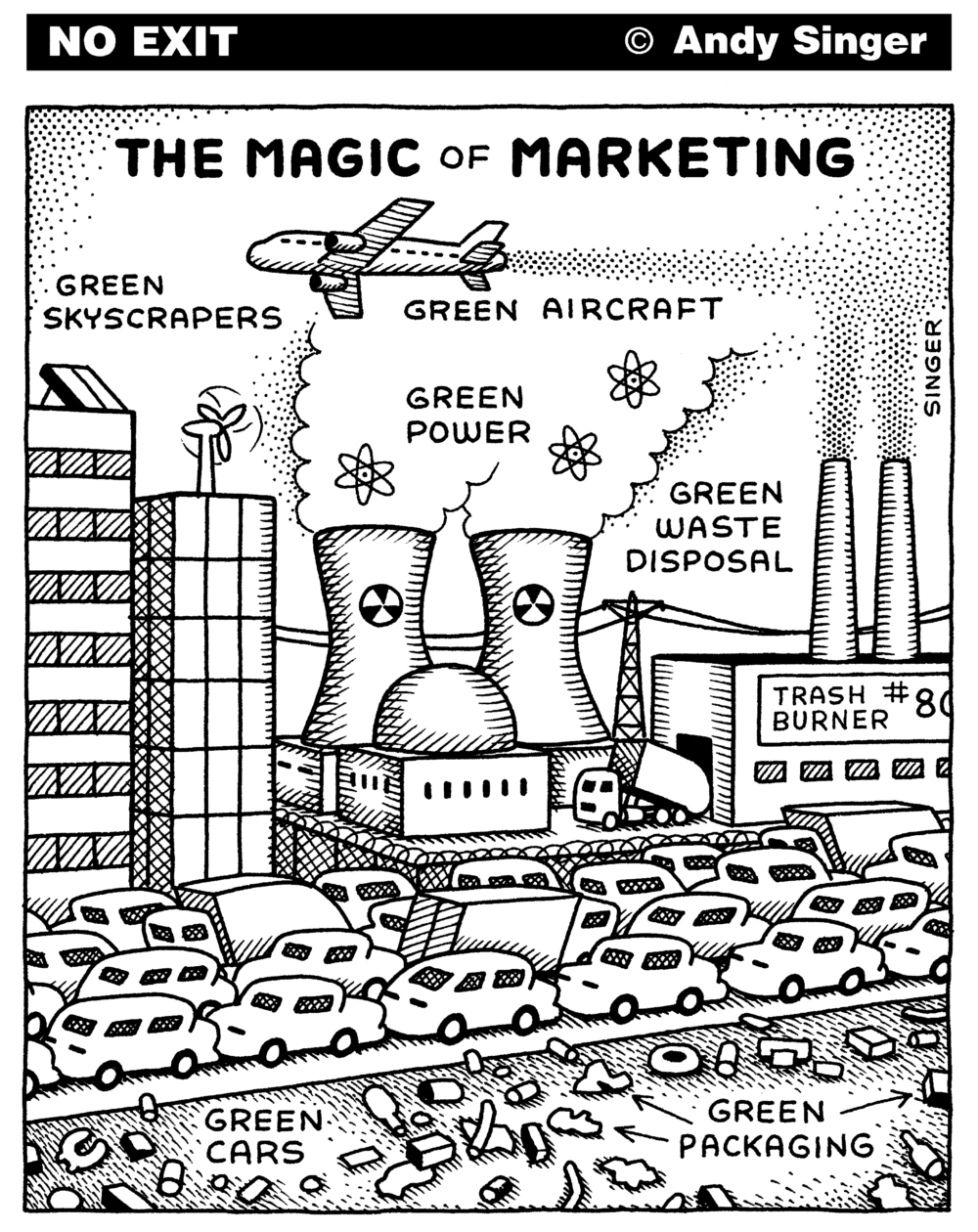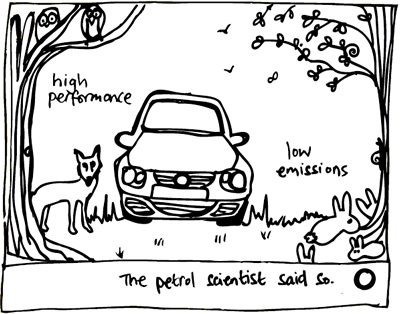Greenwashing and green marketing have certainly contributed to a challenge we face today. As Albert Einstein once said “We can not solve problems by using the same kind of thinking we used to create them.”
Recently I came across an interesting and yet controversial article on the topic. Joel Makower, chairman and executive editor of GreenBiz Group Inc. shared some thoughts. He nicely stirs the pot of one of my favorite topics. Below is the full article as well as some of the comments readers submitted online.
***
Sometimes, it’s hard to face reality, especially when a dream is so alluring. And the alluring dream of green marketing is this: that consumers would cast a vote in favor of a more just and sustainable world whenever they shop.
But the reality has been vastly different. For more than 20 years, consumers haven’t been willing to vote with their dollars. The reasons are many and complex, but the result is clearcut: With the exception of some energy-saving devices, no green product has captured more than a tiny slice of the marketplace, at least in the U.S.
Think about it: No environmentally preferable car, carpet, cleaner, cosmetic, clothing, coffee, credit card or cell phone has captured more than 2 percent of its respective market. In most cases, sales of green products represent well under 1 percent of any given category.
Even where green products do seem to be selling, it’s not primarily because of their environmental benefits. Organic foods? It’s about what we put into our bodies. Hybrid cars? They reduce costly trips to the pump. Energy Star TVs and appliances? They cut energy costs. It’s not really about the planet.
Green marketing should not be confused with public service campaigns aimed at getting people to change habits and adapt a more environmental consciousness. Changing habits is a fundamental part of cultural shifts. Toting reusable shopping bags, biking or taking public transit instead of driving, conserving water and electricity, taking care of parks and greenspace, and all the rest. Green marketing, in contrast, aims at getting people to buy stuff that is better for the environment.
Green marketing’s failure hasn’t been for lack of trying. Activists, community groups, government agencies, faith-based organizations, schools, scout troops, universities, and, of course, companies have been encouraging shoppers to make greener choices for years.
And, as I’ve written about ad nauseum, pollsters and market researchers have fueled the fire. They tell us all the while that large numbers of consumers want to make green choices when possible. A few do. But not many, and not often.
There’s plenty of blame to go around. Companies’ marketing efforts have been largely humorless and uninspirational. Green products themselves have been variously underwhelming, overpriced, inconvenient, ineffective or unavailable.
Too often, green marketers have attempted to prod consumers to act by relying on guilt or by encouraging people to “save the Earth”. Neither has turned out to be particularly aspirational or appealing.
And consumers have made it crystal clear. They don’t want to change, at least in the name of Mother Earth or the greater good. Of course, we change our buying and lifestyle choices all the time. How we communicate (email, mobile phones, texting, Twitter). How we shop (what’s a “record store”?). Wwhat we eat and drink (“functional foods,” anyone?). What we drive and wear and do. But those choices benefit us personally, today — not some far-off forest or future.
The economic doldrums haven’t helped. The New York Times reported in April that sales are down of even the few green products that had been selling, such as green cleaners, as consumers looked for ways to cut costs. That’s been a key part of green marketing’s downfall — the “sustainability tax” associated with premium-priced green goods, as Ogilvy’s Freya Williams, put it recently in GreenBiz.com.
“Bear in mind Walmart shoppers have an average of $65 a week to spend on groceries for their families,” she notes. “If you are trying to work within a $65 budget, there’s just no way you make that kind of premium work, however much you might want to.” She argues that green products should cost less, not more.
It is important to note that all of the above relates only to consumer-facing marketing. The business-to-business landscape is wholly different. A wide range of things companies buy are being marketed effectively for their environmental attributes. Building products, industrial cleaners, IT equipment, paper and forest products, appliances and some industrial feedstocks – you name it.
Companies and other buyers (like government agencies, hospitals and universities) are more willing to change their buying habits. Their buying power can make for attractive economies of scale. Witness the continued market growth of green buildings, biobased packaging, alternative-fueled fleet vehicles and more.
But consumer-focused green marketing is just not working. It never really did, it was a noble experiment in social and market transformation, and it has largely failed. And continuing to think it will somehow make a difference isn’t just folly, it’s counterproductive. It’s time to declare defeat and move on.
 Five Reasons for Green Marketing to Go
Five Reasons for Green Marketing to Go
1. It’s not working. For all the hue and cry by green marketers over the years, shoppers seem as conflicted and misinformed as ever. I’ve pointed it out repeatedly through a myriad of polls and market research studies. Suzanne Shelton, who runs the advertising agency The Shelton Group, recently explained to me some of the challenges.
“People don’t trust companies even though they want them to act, though they do trust brands.” At the same time, she noted, “We know that the number-one way people determine a product is green is that they read the package.”
The number-one way people determine a product is green is by reading the package so #labeling is key. Click To TweetSo, they trust the brand, but not the company behind the brand, though they trust the marketing claims the company makes on its package. Is it any wonder that, when it comes to making green choices, consumers don’t know what to do?
2. It remains a niche activity. Most of the major product purveyors have opted out of green marketing, or have dabbled in it so timidly as to relegate it to a single brand or product line. Of the 10 largest advertisers in 2010 (Procter & Gamble, AT&T, General Motors, Verizon, News Corp., Johnson & Johnson, Pfizer, Time Warner, General Electric and Walt Disney), only two — GM and GE — have tried in earnest to market products as green. One of those, GE, is largely B2B.
3. It’s not moving the needle. After all these years, green marketing isn’t making any real difference. It’s not changing consumer habits. It’s not causing a significant shift in the kinds of goods and services companies are selling. And it’s definitely not making a dent in addressing climate change, water and food security, biodiversity, energy prices, or any of our other serious environmental and economic challenges.
Ironically, there’s a new generation of companies that stand to make a difference. Even though they don’t typically market themselves are green. Those are the growing corps of so-called collaborative consumption (or mesh) companies.
A new generation of companies stands to make a difference, even if they don’t typically market themselves are green. Click To TweetThey facilitate the sharing or reuse of products and services. For example, car-sharing or home-trading services, exchange of many goods – from food to fashion. You name it.
These firms embody what sustainability is all about: reducing needless consumption, getting maximum value from physical goods, connecting people, creating community, sharing. These firms typically don’t market themselves or their services as green or sustainable. They’re simply better.
They’re not alone. Many technologies are, relatively speaking, greener. iTunes, ebooks, email, PDFs, and others have radically dematerialized and decarbonized commerce. But they’re not marketed that way. They’re just better.
So, what’s marketed as green isn’t moving the needle, while what’s moving the needle isn’t marketed as green.
4. It’s deluding people into thinking they’re helping. Green marketing creates a false sense of engagement and action. That we can simply shop our way to environmental health. And it often creates an excuse for consumers to not do more.
We all know (or are related to) someone who, consciously or not, believes that buying organic foods, recycling newspapers or driving a hybrid car offsets the rest of their personal environmental impact. That is, doing these things somehow makes the world safe for their other purchases, lifestyle and travel choices. Of course, it doesn’t.
We’re all guilty of this, and for good reason. There are only so many changes or sacrifices most people are willing to make for the greater good. And if others aren’t doing these things, why should we?
5. It’s missing the bigger story. Here it is. Most of what we buy has become greener in spite of our unwavering shopping habits. I’ve written about since the late 1980s. Companies are making significant, sometimes dramatic, changes in how they produce what they sell.
They’re far from sustainable, but these companies are getting better and better. And they’re not marketing these things.
 Case in Point
Case in Point
Over the past few months, GreenBiz has written stories about commitments and achievements made by some of the biggest consumer companies and brands:
Adidas, Anheuser-Busch, Avon, Bumble Bee, Heinz, HP, Johnson & Johnson, Kellogg, Kraft, Levis, McDonald’s, Nike, Pepsi, Planter’s, Procter & Gamble, Puma, Smithfield, Sprint, Timberland and Verizon.
That’s 20 companies across a range of sectors, and I haven’t yet broken a sweat. There are hundreds of these developments every year.
I can assure you that almost none of these commitments and achievements is going to show up in product marketing materials or ads. If anything, they’ll be mentioned deep in a corporate website or buried in an environmental report. They’re not being done to sell more stuff. They’re being done because they cut costs, eliminate waste and inefficiency, improve quality and engage employees. That is, for sound business reasons.
Are these companies green, or even good? Not likely. But they’re making a bigger positive impact than most consumers will ever know.
So, green marketing isn’t changing consumers’ minds, isn’t changing things, misleads consumers and doesn’t give companies credit where it’s due. Are there any good reasons to keep doing it?
I’m not suggesting for a minute that consumers opt out of trying to nudge companies, markets and economies toward more sustainable products and practices. But relying on green marketing isn’t the way to make change. Most of it is irrelevant and unhelpful.
What’s helpful? Pushing companies to be transparent and accountable for their environmental (and social) impacts. Transparency has become the new lingua franca in sustainability. It is a demand for companies to account for and report their impacts, commitments, goals and progress.
It’s at the company or brand level that this makes sense: Why offer a few good, eco-labeled products if the organization behind them is headed in the wrong direction? Transparency is a fundamental building block of a green economy. It can build trust in companies, and ward off claims of greenwashing.
Being transparent is no longer a question for consumer-facing companies. The only question is whether they do it themselves or have it done for them.
There are several terrific examples of the latter:
- Greenpeace’s ranking of supermarkets on sustainable seafood
- Climate Counts’ ranking of companies on their climate goals and performance. Disclosure: I’m on Climate Counts’ board.
- The Electronics Takeback Coalition’s ranking of computer companies’ e-waste efforts.
- The Union of Concerned Scientists’ ranking of automakers
- Greenpeace’s (again) ranking of technology companies.
Each of these compares companies and brands using rigorous and consistent criteria, helping to illuminate who’s really walking the talk. They don’t just look at product attributes. they look at the whole enterprise. This isn’t market-speak; it’s accountability.
But for transparency to be effective means consumers will have to put aside their innate skepticism — or, if they prefer, hold their noses — and support leadership companies, even if the companies in question are far from perfect.
Based on what I’ve seen so far, I’m skeptical consumers will do their part. Too often, the public has looked disapprovingly at mainstream brands that have staked out leadership positions in sustainability — I’m thinking of Nike, McDonalds, Walmart and Starbucks, among many others — and written them off as “not good enough” or, worse yet, greenwashers.
(Meanwhile, their less-green competitors get little or no scrutiny.) None of which has stopped these leaders from continuing, even accelerating their efforts. As I said, they’re taking these actions because it’s good business, not necessarily to move merchandise.
Consumers typically have been skeptical. They’d rather see companies “do the right thing” than to make sober business decisions that achieve societal goals. Making money as a green-minded company (or at least as a big green-minded company) is seen as unseemly, disingenuous, even dishonest. So, consumers write off major brands that strive to align sustainability and profitability. “It’s just not believable,” they say. It is greenwashing.
Which gets us back to the problem at hand. Let’s stop pretending that marketing green goods to consumers is somehow going to create a sustainable economy. It hasn’t yet, and I’m not seeing any indications that things are going to change.
There’s plenty of hard work to do on the journey from here to sustainability. Dilly-dallying with green-marketing come-ons is a distraction.
***
Something From The Comments
Matt Polsky
While reading the comments under Joel’s article, I found one that mirrors my views – instead of yelling at companies for greenwashing us, why don’t we hold consumers responsible as well? The comment was submitted by Matt Polsky and it goes as follows:
While much of what was written by Joel and in response about the current-niche market for green, the need to emphasize benefits when speaking to consumers, and cost-savings when talking to businesses, is right—up to a point, we’re letting consumers off the hook.
Joel acknowledges their general lack of interest, but we’re too quick to leave it at that. In contrast, I’d put greater responsibility on consumers, which is not to say the other complementary actions respondents have discussed don’t also have to be improved.
Why shouldn’t consumers be called upon to step up, and criticized when they don’t? Sure, that doesn’t mean they should buy bad green products, or that a period of some confusion about claims won’t exist. But the prevailing assumptions: “Well that’s just the way they are,” and “there are good, unchangeable reasons for that” need to be re-imagined.
Consider these factors regarding greenwashing: Too often consumers don’t seem to realize what’s at stake, or see the consequences of their cumulative actions
They assume the status quo baseline environmental conditions that enable them to enjoy a livable planet will always be there, or else are unaware or oblivious to ecosystem services
They don’t appear to accept an ethical obligation to those disproportionately at risk from global warming, whether Pacific Islanders or penguins.
Many of us are the same people who criticized President Bush for telling people after 9/11 to “go shopping,” instead of calling on us collectively to sacrifice for the greater good, at a moment when we might have heard him (What would we have thought if he had said: “Go green shopping?”)
Similarly, some of us criticize (well, with mixed feelings) the absence of a draft, because 99% of the burden of defending whatever it is you think is at stake in Iraq, etc. (including supplies of cheaper oil) falls on our soldiers and their families, while the rest of us just go on with life, without connecting the dots.
It’s similar to the disappointing performance of people, when in their citizen roles, of low frequency of voting, inaccurate knowledge in certain areas (e.g. the large overestimate of the percentage of the federal budget that goes to foreign aid), and the small percentage of people who are willing to donate blood or their organs when the need is so great.
Remember that democracy is a bold historical experiment. It is not by default that peoples’ ability to self-govern will work in the long run.
#Democracy is a bold historical experiment. It isn't by default that peoples can self-govern in the long run. Click To TweetNor is it true that all required actions to make the political, economic, or environmental systems work have to be easy or pleasurable to hear. To make them work, people need to be told when their behavior on the big stuff needs to change. There is no need for patronizing.
If this risks coming across as moralizing, elitist, hypocritical, do-goodership, guilting; then we should consider ways to avoid these qualities if possible; but we need to take the risk, and live with the charges and even ridicule, if necessary.
Secondarily, “sustainability” or “green” applied to any existing field, like marketing, can’t be slap-on adjectives. Practitioners coming into the sustainability world need to think about how the traditional tools and even core assumptions of their fields may need adjustment to be compatible with the principles and values of the former. That would facilitate their needed contributions.
If we believe we’re in a sustainability crisis, then that sets the context for everything else. Therefore, we can’t afford to go forward without a strong green marketing field, but also one which accepts the broader interdisciplinary challenge of figuring out how to make buying green the general default choice.
One thing which might be helpful is to redefine the core marketing concepts of “benefit” and “need” so they don’t just relate to “me and my comfort.” Perhaps benefit should also include aiding a consumer’s sense of making a legitimate (albeit partial) contribution to addressing the challenges before us.
I don’t think that connecting the dots is beyond consumers’ capabilities. The field of environmental education, which aims to foster this deeper identity between the individual and the natural world, might be helpful.
Brendan May
Here is a different angle to the topic of greenwashing:
Interesting article, but a VERY US centric view. In Britain, Rainforest Alliance certified tea now accounts for half the tea market (at least). All the major tea brands now carry and market with Rainforest Alliance seal of approval. At Easter time, all the major chocolate egg manufacturers make a virtue of reduced packaging around the product.
There are millions of other examples. It may be niche and small (still) in the USA, but that doesn’t mean the game is over or that it didn’t work. Perhaps it hasn’t started yet on your side of the pond. Plenty of multinationals report direct increases in sales when green marketing campaigns are credible and part of a bigger corporate strategy.
Greenwashing Definitions exposed here:
Irv Einberg
I especially like this one.
Joel just declared that “Green Marketing is Over.” To quote Mark Twain, “The rumors of my death have been greatly exaggerated.” I think the same applies to green marketing.
“The rumors of my death have been greatly exaggerated.” Mark TwainClick To TweetAt Mind Over Markets, we’ve been saying for years that green marketing messages’s communication is not correct and effective right from the start.
The first task of green marketing, like all other marketing, should be an analysis of benefits. First to the consumer, and then to the planet. Too many opted for the latter, save the planet, as though you could with your cleaners and your pizzas. That never made any sense to me and it never will.
When Nissan Leaf used a polar bear hugging a man in their commercial instead of laying out the many advantages of EV’s to me and my life, when they don’t position their vehicles as personal benefit producers, when they don’t tell me what’s in it for me, then yes, green marketing is over.
When organic food does not have an image as better for your health, better tasting, fresher, more local and ultimately more enjoyable, no wonder it’s hard to justify the higher costs. The success of Whole Foods probably related more to their gourmetness than on their greenness. They have the recipe right and continue to succeed.
The last time I saw a green marketing obituary it was centered on the failure of Organic Ragu Sauce. As though any organicite or foodie was going to buy Organic Ragu or Organic Heinz Ketchup. That wasn’t a failure of green, but a failure of logic. When the largest manufacturers of caustic and corrosive cleaning solutions suddenly turns green, its no wonder that consumers scratch their heads and wonder if it’s real or just a mask.
When Kimberly Clark tells us they they’ve done “green right” instead of telling us that recycled paper is a better, saner way to make napkins and toilet paper than destroying old growth forests, no wonder we yawn and walk away.
To my mind, it’s not the failure of green marketing, but the failure of green marketers to have thought it out long enough and strategically enough to hire true green marketers and visionaries who actually understand not just the heart of green consumers, but the minds of the greater population.
Instead they wheeled out Kermit the Frog and melting icebergs. They should have been selling their products to me instead of making my purchases seem like a cause, charity, public service or a sacrifice that I have to make. By the way, you can’t actually save the planet all by yourself.
Talk about naive. At a time when people aren’t sure they can save themselves, much less the planet, is it any wonder that kind of thinking or marketing is on the endangered species list?
What’s saddest of all is that all the so called “green experts” failed in their expertness when they didn’t alert marketers that they were on thin ice right from the beginning.
When they didn’t understand the balance of message, the need for benefits, and the need to tell consumers that they were not only doing what was right, but what was smart.
It really is a shame that the lemmings will watch the green hearse go by and help drive green even further off the cliff. That others will continue to not only sell, but tell things wrong and then lament the passing of one of the most significant opportunities to actually make things better for all of us.
Consumers tire of buzz words. In order for Green #Marketing to work, we need to give it tangible meaning. Click To TweetUndoubtedly, consumers fatigue of buzz words – planet, green and – certainly soon enough – sustainable, just don’t make the bang. In order for Green Marketing to work, we need to give it tangible meaning. This is a whole new beginning.
Credit: “Green Marketing is Over, Let’s Move” on GreenBiz
Check out our articles on Plastic Recycling in Taiwan – Green Gold, Tackling Electronic Waste, Pollution Infographic, Poison in Your Make-Up, Plastic Bottles Recycling or Landfill


















Leave a Reply